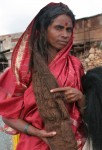In 2004, I traveled to Hubli in Karnataka, India to investigate a temple which allegedly still had devadasi, traditional temple dancers cum prostitutes. The Indian government had already made moves to ban the practice of enslaving young girls in Brahmin temples but old tradition tend to linger in India.
I think this story has never been published in its entirety. As far as I recall, Marie Claire ran some of the images with long captions in 2005.
Photographs by Aroon Thaewchatturat.
So here’s the story of the Sex Angels of Life and Insanity….
“My name is Yellamma, I have been a devadasi all my lfe. I am the last of ten children and I was born with matted hair. It’s always been like this.”
The parched plains of western Karnataka stretch towards a low, monsoon-laden horizon. The soil in this part of India is poor. Farmers barely eke a living from the tired ground. Villages, dirty, run-down settlements infested with semi-wild dogs and unruly herds of goats, lie by the side of potholed roads, abandoned by all higher authorities.
At dawn the women are out, getting another hard, hopeless day started – washing, cleaning and cooking – while the men smoke their first bidis and wait for better times. The clouds already hang low in the sky, their heavy blackness about to touch the ground, promising nothing but trouble. All around the trader’s city of Hubli, which is remarkable only for its commonplace ugliness and pollution, life is static, suspended between past and future. The people, even the children, look old and tired. As the new day creeps up on India, hundreds line the roadsides for their morning defecation. Human feces and plastic bags lie about everywhere you go. This is an India of untold suffering, only a few hours from the beaches of Goa, remains hidden from most visitors.
This tragic land is blessed and cursed with one of India’s most suppressed, brutal and ancient secrets – it is the last refuge of the Devadasis – girls who were once given to a temple by their parents and trained as dancing angels to the Hindu pantheon. More often than not, these unfortunate girls ended up as prostitutes to the Brahmin priests who ran the temple and were later sold into brothels across the subcontinent. Finally they gathered in the arms of their goddess and many embrace insanity as a last refuge from a cruel world.
Devadasis are unsung victims of history and progress. Their time on earth is almost spent; the notion of ‘modern’ India – a disintegrating faith and an increasingly intolerant and materialistic society – have pushed these women to the margins of society. The Indian government does its part to accelerate the process. While the induction of Devadasis is now illegal (though it continues secretly in rural Karnataka), little is done to free, rehabilitate or support women who are or were Devadasis.
The exclusion of these women from mainstream society is absolute. No Hindu man will marry a Devadasi, whether she has been a divine servant to the gods or a former sex worker. Their parents don’t want them back. There is no social network or welfare for single women in India. Once abandoned or free, the Devadasis have but one place left to go.
Fifty miles northwest of Hubli, a low long hill rises out of the mud and dust. From a great distance, a sole TV transmitter can be seen on this barren plateau that stretches for a mile to the east. At the foot of this hill, the small town of Saudatti clings to a slowly eroding ravine. On a tiny hillock, a solid fort, built by a local ruler in 1777, once served as protection from rural marauders and now appears to be waiting for tourists – it’s likely to be a long wait.
A narrow road leads past Saudatti and up onto the plateau. A few one-room concrete shacks are stacked on steep rocky ravines. The only work up here is splitting rocks – the poorest of the poor live in makeshift tents by the side of the road and do just that, all day. Even in June, before the start of the great rains, it is cold up here.
We round a curve and a huge sign shows a policeman holding a set of handcuffs over the heads of several old women. Devadasis beware, the police are after you. The next curve brings us to a concrete gate. The roads leads on through make-shift markets and ends in front of a low temple complex that lies in the center of a gully, enclosed on three sides by rocky, rubbish-strewn ravines. The temple isdedicated to the goddess Yellamma.
As we stop the car, a crowd of women, bearing trays filled with cowrie-shells and a brass icon of the goddess, close in, gesticulating, shouting and fighting each other to bless us and apply a yellow smear to our foreheads.
Yellamma is an incarnation of Parvati, the consort of Shiva. As such, Yellamma is a highly benevolent deity, a spirit guardian of women and this is her temple.
Only a couple of days earlier we had been sitting in a restaurant near the UNESCO World Heritage Site Hampi, a hundred miles to the east, discussing an email a friend had sent us. Our friend was urging us to visit the Yellamma temple and try to trace some of the last temple dancers of India. They would be easily recognizable. The devadasis all had matted hair, he’d said, similar to Indian holy men, which was never cut nor washed and considered an external aspect of their divinity. The state government, our friend told us, forcefully shaved former devadasis at their only refuge, the Yellamma Temple,the government apparently embarrassed by an old superstition that leads to the exploitation of women.
As we sat talking, a woman in a green sari, followed by two men, walked past. As she passed, the back of her head flipped around – the woman had matted hair, grown into long curls that reached down to her waist. I approached the men with a polite namaste. They were the first young males I had ever met in India who had no desire to exchange even a greeting. They barely stopped. We politely nodded at the woman, but she stared straight through us, and the strange three-some started walking away unwilling to communicate. In the distance I could see a couple of security guards from the temples. I knew that one of them spoke some English. I asked him to help us translate.
We caught up with the woman and her sidekicks a second time. I asked the guard to ask them where they came from, and the guard asked them in the way men in uniform usually ask questions. The men looked shifty, the woman resigned. She wore gold earrings and her arms were badly scarred. Her companions explained that they were from Kharwar, on the coast. The older man claimed to be the woman’s wife. The younger man didn’t say anything. Neither of them offered their names. Eventually the woman explained that she had had the locks since she was a young girl and that she was devoted to Shiva. They left.
The Yellama Temple is hardly a remarkable building, yet the site has a strong dark power. The courtyard is almost deserted. A young man and an older woman in a pink sari, perhaps his mother, perform five prayer rounds around the central building. Every few meters, the young man prostrates himself on the wet ground, which is saturated with yellow and red tikka ink, coconut milk, the dust of a thousand incense sticks and the hopes and prayers of the millions of pilgrims who stream through the temple during several enormous festivals held here every year. On the footpaths around the temple, old women with matted hair sit begging or talking to themselves.
The Brahmin priests inside the chamber with the temple’s deity are unfriendly, perhaps they are tired of strangers poking their noses into Hinduism’s murky underbelly.
As we emerge from the sanctum into the courtyard, a tall woman in a red sari, carrying a travel bag and a chowri, a kind of scepter with a thick bushel of black hair, a small solemn-looking boy in tow, floats past us. She looks imperious and stares at us without fear. Her green eyes are piercing. But she does not stop and as she rounds the corner, an enormous plat of matted hair that sticks out from under her long headscarf, almost touching the floor, becomes visible.
On the temple roof, the woman makes an offering to Yellamma, the goddess whose name she has taken.
“I have never been married, I have no children and I visit my local temple every day to make puja for my goddess.”
She calls herself Yellamma and lives in the village of Kanagau, where she tends her fields and shares a home with her family. The silent boy is her sister’s child.
“I have never lived in a temple,” she says, with all the confidence of a seasoned socialite. “I visit this shrine once or twice a month, but never during the festivals.” And she laughs, “and the police have never tried to cut my jaedi.”
Her hands are soft and manicured, her manner self-assured and she shows little reaction to the large crowd that is quickly building up around us.
Jaedi is is the local term for the matted hair, the symbol and pride of the devadasis. The state government has been sending social workers to Saudatti in recent years. The social workers come to cut the jaedi off the devadasis heads, making an example of them, parading their backwardness and destroying what little pride they have left. This is supposed to stop the practice of inducting Devadasis into the temple life. But this tradition of enslavement has simply been driven underground and the old devadasis of Yellamma bare the brunt of the authorities’ actions.
A woman in a pink dress suddenly approaches and leans into the conversation, shouting at no one in particular, before slapping my head and rushing off. Her jaedi has fallen victim to the government’s efforts and Yellamma tells us that she has gone insane with grief, speaking in tongues and wandering the temple grounds aimlessly.
Next to the temple, a wide stairway leads past souvenir stalls and chai shops, upwards to the rim of the gully. Beggars, mendicants, pilgrims and old ladies linger here. An old devadasi is walking, as if in a daze, with a basket and some tika powder, begging for alms.
“Why do you want to know my name?” she asks aggressively. A shadow of fear passes over her face. “I have no reason to talk to you.”
By 9 am the word is out. There are foreigners about, asking questions. Too many questions. The devadasis have disappeared. Only the insane still linger round the outer temple walls, oblivious to our presence.
Yellamma and the boy rush off to catch the bus home. Without her presence, the temple looks gloomy and frightening.
According to the local media, girls continue to be kidnapped into the devadasi life in rural Karnataka, while the aging representatives of a dying, once respectable institution are hunted down and branded like animals.
The Goddess Yellamma, ‘Mother of the World’, as she is called by some Hindus, looks on silently, perhaps knowing that there is as little room for a goddess as there is for a temple dancer in the modern progressive world much of India now aspires to.


